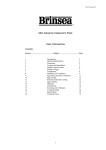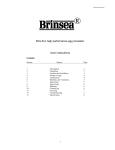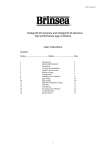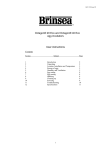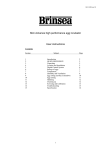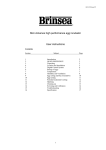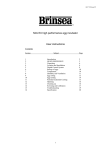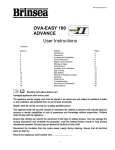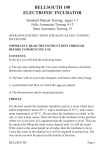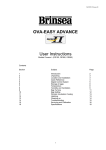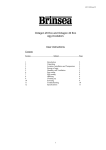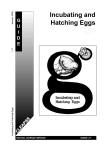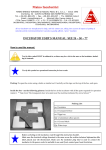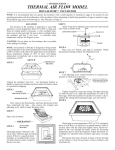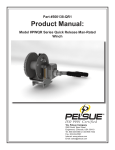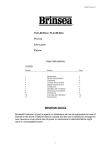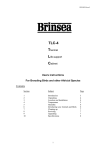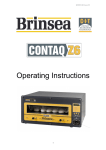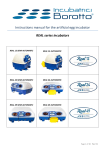Download Octagon® 20 Advance Classroom Pack User instructions
Transcript
N510C US Issue 03 ® Octagon® 20 Advance Classroom Pack User instructions Contents Section 1 2 3 4 5 6 7 8 9 10 11 12 13 14 15 16 17 18 Subject Introduction QUICK REFERENCE Unpacking Location and Installation Digital Control System Storage of eggs Temperature Humidity and Ventilation Egg setting Egg turning Periodic Incubation Cooling Egg candling Hatching Cleaning up Servicing and Calibration Troubleshooting Specifications Technical Notes 1 Page 2 2 4 4 6 7 8 8 10 11 11 12 13 14 14 16 17 18 N510C US Issue 03 1 Introduction These instructions detail the operation of your new Octagon® 20 Advance incubation system. Please read these instructions carefully before setting up your machine to achieve best results and keep these instructions safe for future reference. This document includes recommended procedures for successful hatching but incubation involves the control and manipulation of a large number of factors and in certain circumstances different procedures may be necessary. Your incubator is designed to allow the user to vary the incubation conditions to suit a wide range of species in different ambient conditions and the specific set-up for every situation is beyond the scope of these instructions. There is a range of books available covering incubation techniques, for more information or to request a book list please don’t hesitate to contact us. The Octagon® 20 Advance incubator is available with the option of the Advance Humidity Pump for automatic humidity control. Operating instructions for this module are supplied separately. Fig. 1 Functional features of the Octagon® 20 Advance Digital Display Temperature Control Housing Cable Cover Control Buttons Adjustable Air Vent Turning Motor Housing Autoturn Cradle 2 Quick Reference (please read relevant section for detail) This quick reference is intended to allow users familiar with the Octagon® 20 to quickly set up the incubator and learn the key features of the control system. Please read the rest of the instructions to obtain a full understanding of each feature. DO NOT COVER THE INCUBATOR. FOR INDOOR USE ONLY. 1) Carefully unpack the incubator (section 3) 2) Assemble the cradle (section 4) 3) Fit the power lead and cable cover – DO NOT OPERATE THE INCUBATOR WITHOUT THE CABLE COVER, ENSURE THE CABLE IS NOT CRUSHED OR PINCHED WHEN FITTING:- 2 N510C US Issue 03 MAIN MENU – QUICK REFERENCE PRESS BOTH BUTTONS TO UNLOCK THE MAIN MENU SELECT THE OPTION / RETURN TO THE MENU. GO FORWARD ONE SCREEN / INCREASE THE VALUE / DISPLAY IN CELSIUS. GO BACK ONE SCREEN / DECREASE THE VALUE / DISPLAY IN FAHRENHEIT. TEMP OK 37.5C OK - + INCUBATION TEMPERATURE. RANGE 20.0 – 40.0°C (68.0 – 104.0°F). DEFAULT 37.5°C (99.5°F). RELATIVE HUMIDITY. RANGE 20% – 80%. DEFAULT 20%. ONLY FOR EX VERSION WITH ADVANCE HUMIDITY PUMP – SEE SECTION 8.7. RH% OK RH 20% EX ONLY ALARM HI OK HI OK 2.0C - + HIGH TEMPERATURE ALARM. RANGE 1.0 – 5.0°C (1.8 – 9.0°F) ABOVE SET INCUBATION TEMPERATURE. DEFAULT 2.0°C (3.6°F). ALARM LO OK LOW 3.0C OK - + LOW TEMPERATURE ALARM. RANGE 1.0 – 5.0°C (1.8 – 9.0°F) BELOW SET INCUBATION TEMPERATURE. DEFAULT 3.0°C (5.4°F). COOLING OK MINS OFF OK - + PERIODIC INCUBATION COOLING. SWITCHES HEATER OFF FOR A TIMED PERIOD ONCE EVERY 24 HOURS (SEE SECTION 11). RANGE 60 – 360 MINUTES. DEFAULT - OFF. C/F OK DISP C OK C F CELSIUS / FAHRENHEIT DISPLAY. SWITCHES ALL TEMPERATURE FIGURES BETWEEN °C AND °F. DEFAULT °C. SAVE. ALL CHANGES ARE SAVED. RETURN TO NORMAL OPERATION SCREEN. SAVE OK CANCEL. ALL CHANGES ARE IGNORED. RETURN TO NORMAL OPERATION SCREEN. CANCEL OK 3 N510C US Issue 03 3 Unpacking Your incubator has been supplied in protective packaging. Please remove all tape, strapping and packing from the incubator and parts. Retain the carton and packing materials to enable the unit to be repacked. Your incubator system will include as standard: Quantity Item Incubator 1 1 1 1 1 1 Incubator (including removable lid) Egg tray Cable cover and screw Mains cable Set of six egg dividers Guarantee card Autoturn Cradle:- 2 1 1 1 Base bars Motorized cradle end Plain cradle end Set of four bolts Brooder Module:- 1 6 Clear molding Slotted plastic enclosure panels Candler:- 1 OvaView candling lamp Egg Viewer:- 1 OvaScope egg viewer Feeder:- 1 1 Feed trough Drinker 1 1 Quart non-drowning drinker Disinfectant 1 100ml Incubation Disinfectant Concentrate CD-ROM 1 Lesson plan on CD-ROM 3.1 Please identify each part and check that they are all present and undamaged. If there are any parts damaged or missing please contact your retailer or Brinsea® Products (at the address at the end of the document). Damaged appliances shall not be used. 3.2 Note that if your incubator has been ordered with additional options (such as the Advance Humidity Pump) separate instructions and component lists apply. 3.3 Check also that the electrical supply matches the machine’s requirements (marked on the technical label on the inside of the lid of the incubator and on the inside of the blank Autoturn cradle end). 3.4 To register your new Brinsea® product please visit www.brinsea.com and follow the link under Customer Service on the top navigation of the home page to qualify for your free 2 year guarantee covering your incubator. 3.5 Go to www.Brinsea.com and register as a free member of the Brinsea® Email Group to receive the latest news and information such as advance notice about new products, special offers, exclusive competitions and much more. 4 N510C US Issue 03 4 Location and Installation 4.1 Your incubator will give best results in a room free from wide temperature variations and with generous ventilation – particularly if several incubators are running at the same time. Ensure that the room temperature cannot drop on a cold night. Ideally thermostatically control the room at between 68 and 77°F (20 and 25°F). Never allow the room temperature to drop below 59°F (15°C) and ensure that the incubator cannot be exposed to direct sunlight. 4.2 Connect the mains cable to the incubator lid. Ensure the connector is pushed fully home in its socket. 4.3 Fit the Cable Cover and tighten the screw. DO NOT OPERATE THE INCUBATOR WITHOUT THE CABLE COVER IN PLACE. ENSURE THE CABLE IS NOT CRUSHED OR PINCHED WHEN THE COVER IS FITTED. The cover is designed to prevent splashes of water reaching the electrical socket and it clamps the cable to prevent the connector coming loose. 4.4 Assemble the Autoturn cradle in accordance with the diagram below (Fig. 2) and place on a flat, level surface (workbench height is ideal). Place the incubator into the Autoturn cradle as illustrated (Fig. 1). The cabinet is designed to locate onto the lugs at either end of the Autoturn cradle. Take care to offer the incubator at the angle which matches that of the drive lug to avoid damage to the mechanism. Ensure full engagement in the slots in the ends of the incubator so that the incubator is level end to end. FIG. 2 4.5 If using without the Autoturn cradle place the incubator upright on a flat level surface. 4.6 Remove the lid, lift out the egg tray and fill one of the two water channels with water or 100:1 Brinsea® Incubation Disinfectant Solution leaving the top of the liquid 3/4” (20mm) from the top of the channel. Replace the tray and replace the lid. Slide the ventilation control to the centre of its range. 4.7 Plug incubator and cradle mains supply cables into suitable outlets ensuring that the cables are not pulled tight. The incubator fan will start, the buzzer sound and the LCD display on the temperature control housing will display the air temperature and humidity. The cradle motor will start and the incubator will begin to turn. The turning is very slow – taking about half an hour to turn each way. 4.8 Allow the incubator to run for at least an hour to stabilize the temperature before making adjustments or setting eggs. 5 N510C US Issue 03 5 Digital Control System T*99.6F H*45% The Octagon® 20 Advance control system utilizes highly accurate, individually calibrated sensors for temperature and humidity. Be cautious of low cost analogue or digital thermometers and hygrometers when comparing them with the incubator display readings. 5.1 NORMAL OPERATION – Temperature and relative humidity are continuously displayed. The asterisk “*” adjacent to the temperature reading shows when the heater power is on. When warming the asterisk will be continuously on, once warmed up the asterisk will slowly flash as the heater is pulsed to maintain the correct temperature. When reducing the temperature setting the asterisk may go off, this is normal. When reducing the temperature setting the asterisk may go off, this is normal. During periodic incubation cooling (see section 11) the asterisk will be replaced by an arrow: “↓”. The asterisk “*” adjacent to the relative humidity display is only on when the pump control output is on (see section 8) and is only applicable when using the optional Brinsea Advance Humidity Management Module. 5.2 POWER LOSS DISPLAY – If power has been interrupted due to a power cut (or when first switching on) a “P” is shown flashing in the corner of the display. Press OK for 2 or more seconds to clear the indicator. If the reason for the power loss is not known check the power cable connections are secure. Once the “P” indicator has been cleared, it is advisable to candle eggs a number of times to check for losses. T*99.6F H 45% P 6 N510C US Issue 03 5.3 HIGH TEMPERATURE ALARM DISPLAY – If the measured temperature goes up by more than the figure in the ALARM HI screen, the alarm will sound immediately and “+T” will be displayed. Press OK to silence the alarm for 30 minutes. If the high temperature problem rectifies itself the “+T” remains on the display to show this has happened. Press OK to clear the indicator. Check the incubator is not (and has not been) in direct sunlight or too near a heat source such as a room heater. It is advisable to candle eggs a number of times after this event to check for losses. T 99.6F H 45% +T 5.4 LOW TEMPERATURE ALARM DISPLAY – If the measured temperature goes down by more than the figure in the ALARM LO screen, after 60 minutes “-T” will be displayed and the alarm will sound. Press OK to silence the alarm for 30 minutes. If the low temperature problem rectifies itself the “-T” remains on the display to show this has happened. Press OK to clear the indicator. Check the incubator is not (and has not been) in a cold draught or that the room temperature has dropped significantly. It is advisable to candle eggs a number of times after this event to check for losses. T*85.1F H 45% -T 5.5 CHANGING SETTINGS – The Main Menu allows the various settings to be modified and saved. All changes are retained in the event of a power cut. To access the Main Menu press the + and – buttons simultaneously to unlock the display. For full details of menu settings please refer to the guide on page 3. 6 Storage of Eggs Remember eggs purchased from your local grocery store are not fertile and will not hatch. Fertile eggs can be ordered from a hatchery or breeding farm. If possible go to a local farm and bring the eggs yourself rather than having them shipped. The Extension service of the nearest University Animal or Poultry Science Department usually have contacts with local farmers and may be able to assist. If you are unable to identify a local supplier please use one of the recommended sources on the form enclosed. 6.1 Store eggs in cool, damp conditions. The best storage conditions are near 55°F (12°C) with 75% humidity. The vegetable area of your refrigerator is a suitable area provided the temperature does not drop below 40°F (5°C). Some species may be safely stored for up to 10 -14 days before serious reductions in hatch rates are likely. Daily turning of stored eggs also helps maintain hatchability. 6.2 Discard cracked, mis-shaped and heavily soiled eggs (if possible). Only wash soiled eggs using a brand egg wash solution such as Brinsea® Incubation Disinfectant Concentrate following the manufacturer’s instructions. It is essential to wash eggs in solution which is significantly warmer than the egg. Bear in mind that all solutions will remove the outer cuticle from the egg as well as the dirt and may leave the egg at greater risk from bacterial contamination in the future. 7 N510C US Issue 03 7 Temperature Stable and correct temperature is essential for good results. Adjust with care. 7.1 Note: your incubator may not be set to the correct temperature from the factory and the following procedure must be followed before setting eggs. 7.2 As the incubator warms up and approaches its control setting the heater on asterisk “*” will change from continuously on to flashing. Allow the incubator to stabilize for at least an hour before adjusting the temperature. 7.3 Press the - and + buttons simultaneously to unlock the main menu. Press OK to select the temperature screen and adjust as necessary using the + and – buttons. Press OK to return to the Main Menu and then scroll down to Save. Press OK to save the changes. When reducing temperature the asterisk may go out while the incubator cools – this is normal. 7.4 Refer to the digital temperature display to check temperature. The display shows the air temperature in increments of 0.1°. Adjust temperature with care – small differences have large effects on hatching performance. 7.5 The Display can be switched to show all temperature settings in degrees Fahrenheit. Press the - and + buttons simultaneously to unlock the main menu. Scroll to the C/F option and press OK to select the C/F display screen. Press the + button to select °F or the – button to select °C. Press OK to return to the Main Menu and then scroll down to Save. Press OK to save the changes. 7.6 Recommended temperatures: Typical incubation period: Hens 37.4 – 37.6°C 99.3 – 99.6°F 21 days Pheasant 37.6 – 37.8°C 99.6 - 100°F 23-27 days Quail 37.6 – 37.8°C 99.6 - 100°F 16-23 days Ducks 37.4 – 37.6°C 99.3 – 99.6°F 28 days Geese 37.4 – 37.6°C 99.3 – 99.6°F 28-32 days 7.7 Developing embryos are fairly tolerant of short term temperature drops and the user need not be concerned about cooling that occurs when inspecting eggs. Temperatures above ideal can quickly have a serious detrimental effect on hatch rates and must be avoided. 7.8 The Octagon® 20 Advance has a built-in temperature alarm which warns of high or low temperatures. See section 4 for details. 8 Humidity and Ventilation Short term variations in humidity are not important. The average humidity over the incubation period needs to be near optimum to achieve the ideal weight loss. High humidity for the day or two of hatching is also important. Beware chronic, excessive humidity. 8.1 Two factors affect incubation humidity: water evaporation within the cabinet (from eggs as well as from additional water) and levels of ventilation. The water content of the air being drawn through the incubator will also have an effect. 8 N510C US Issue 03 8.2 There are two methods available to bird breeders to achieve correct humidity levels in the Octagon® 20 Advance: A) Monitor humidity levels and adjust to match published guidelines for different species. Generally accepted incubation RH levels for species groups: During incubation Poultry Waterfowl Parrots 40-50% RH 45-55% RH 35-45% RH Hatching All species 65% RH or more For more specific information on particular species’ requirements check the relevant literature. B) Monitor egg weight loss which varies as a direct result of humidity and correct against published weight loss figures for the species. Eggs lose moisture through their shells and the rate of evaporation depends on the humidity levels around the eggs and the shell porosity. During incubation eggs need to lose a fixed amount of water which corresponds to a loss in weight of around 13-16% depending on species. By weighing eggs periodically during incubation it is possible to monitor and, if necessary, correct humidity levels to achieve the correct weight loss. Weigh the eggs on the day they are set in the incubator, take the average weight and plot this on a graph (see example below). The ideal weight loss line can be plotted by joining the point representing initial average weight with the ideal hatch weight (13-16% less depending on species) with the x-axis representing the incubation period (in days). By measuring actual average weights every few days the actual weight loss can be plotted and compared to the ideal weight loss line and corrections can be made. For example if the actual weight loss was greater than ideal (see graph below) then the air has been too dry and humidity levels need to be increased to compensate. Typical ideal weight losses for species groups: Poultry Parrots Waterfowl 13% 16% 14% Average egg weight (grams) Egg weight loss chart Ideal weight (grams) 68.0 66.0 64.0 62.0 60.0 58.0 56.0 54.0 Measured weight (grams) Incubation period (days) 8.3 Of the two methods given above the most reliable is egg weight method and is recommended – particularly where poor hatch rates are experienced or if eggs of high value are being incubated. 8.4 Alter the setting of the ventilation control (reduce ventilation to increase humidity) and have water in neither, one or both of the water channels to change the humidity level. Humidity levels may be further increased by 9 N510C US Issue 03 placing strips of evaporating card or cloth into one or both of the water troughs. Evaporating card is available from Brinsea® Products. Folded evaporating card 8.5 In all cases the humidity for hatching needs to be high. Because of the short duration involved water/weight loss will not be significantly affected. High humidity is necessary to prevent membranes drying and hardening before the hatch fully emerges. Humidity will naturally increase as the first eggs begin to hatch and internal membranes begin to dry. This effect is in addition to the increased area of water evaporation from the water channels. 8.6 During hatching the high humidity levels will fall dramatically when the lid is opened and will take some time to build up. Resist the temptation to lift the lid frequently – leave for at least 6 hours between inspections. 8.7 The Brinsea® Advance Humidity Pump is available as an option on the Octagon® 20 Advance incubator. The incubator digital control system not only reads the humidity in the incubator but it provides a control signal to operate the water pump and accurately maintain the humidity level at the desired level. 9 Egg Setting 9.1 The Octagon® 20 Advance is designed to be as flexible as possible, accommodating eggs of different sizes up to (and including) goose eggs and in different orientations. Some experimentation may be necessary to maximize capacity. 9.2 Before setting eggs ensure that the incubator has been run for several hours and has stabilized at the correct temperature. 9.3 Set the eggs in rows between the wire loop dividers. The dividers must be positioned such that the eggs rest on the tray bottom and are not pressured by the bar. The dividers prevent the eggs rolling. Eggs may be set on end (or at an angle) provided the large end of the egg is upwards. Eggs rolling through a few degrees between the dividers as the incubator turns are not in danger. 9.4 Once the eggs have been set the temperature must not be adjusted for 24 hours to allow the eggs to warm. Check the water level every 3 days or so and temperature daily. Candle the eggs after 1/3rd of the incubation period has elapsed to reject clear, infertile eggs (see section 12). 10 N510C US Issue 03 10 Egg Turning Warning: NEVER MANUALLY TURN THE INCUBATOR WHILE IT IS ON THE CRADLE, this will damage the turning mechanism and invalidate the guarantee. 10.1 The Autoturn cradle will continuously turn the incubator and eggs on an hourly cycle (through 90° and back) while plugged into the mains supply. Some small intermittent movement due to play in the gears is normal and does not cause harm. Lubrication of the plastic linkage with WD40 helps to ensure smooth, silent movement. 10.2 Ensure that nothing can impede the movement of the incubator on the cradle (such as a mains cable or having the incubator too close to a wall). 11 Periodic Incubation Cooling Bird breeders have known for many decades that eggs can be cooled for limited periods of time during incubation without causing problems but recent research has shown that hatch rates can increase significantly as a result of cooling. This research was carried out with poultry but it is generally accepted that the benefits can apply to waterfowl too. Cooling is an entirely natural process as most birds will get off the nest at least once a day and leave the eggs unheated for a significant time. From Brinsea’s 35 year experience, the best hatch rates are always achieved when the incubator can best mimic the natural nest conditions. The precise details of which days and what cooling period each day should be used for best effect are not known but Brinsea® have assessed the available research and recommend the following daily cooling periods from day 7 through to 2 days before they are due to hatch (the same point that automatic turning would normally be stopped). Smaller poultry, waterfowl and game bird eggs: Larger species eggs (e.g. duck and goose): 2 hours each day 3 hours each day Cooling is not recommended for parrots and birds of prey because the results of cooling haven’t yet been established. For further details please visit the Brinsea website at www.Brinsea.com/cooling.html 11.1 The periodic cooling feature turns the incubator’s heater and low temperature alarm off for a selectable period but keeps the fan running. After the cooling period is complete the incubator reverts to normal temperature and the alarm is automatically reset. 11.2 SETTING THE COOLING PERIOD. The cooling function is optional and may be adjusted. Press the - and + buttons simultaneously to unlock the Main Menu. Press + to scroll to the cooling option. Press OK to select the cooling screen. Use the + and – buttons to select OFF, 60, 120, 180, 240, 300 or 360 minutes cooling. Press OK to accept the figure and then scroll to SAVE and press OK to save the changes. 11.3 Each cooling period starts at the same time each day (24 hours between start times). The first cooling period will start after the incubator has been switched on for 24 hours. If there is a power interruption the 24 hour delay starts again. 11.4 During the cooling period the heater asterisk goes off and an arrow “↓” is displayed. When the cooling period ends the asterisk is shown and the incubator warms to incubation temperature. The time taken to return to incubation temperature depends on the room temperature and may take 30 or more minutes. 11 N510C US Issue 03 12 Egg Candling The OvaView candling lamp supplied is a scientifically designed, purpose made lamp for inspecting the embryo development during incubation. The OvaScope egg viewer allows this to be done without the need to darken the room. Never look directly into the light source. 12.1 Eggs may be examined for fertility after about 7 days. Infertile eggs will appear clear and can be rejected. Hold the OvaView close against the large end of the egg so that the soft nose cone excludes all light except that which is directed through the shell. Darken the room to improve clarity or use the OvaScope as shown in its instructions. 12.2 Usually checks for fertility and air sack estimates can be done without removing eggs from the incubator tray. For closer examination of embryo structures it is best to pick up the eggs and inspect from different angles or with the OvaScope viewer. 12.3 Air space estimation can be made using the following chart. If the airspace is too small, reduce humidity and vice versa. 1 2 1 10 20 3 7 4 5 6 1) Clear when candled - probably infertile (or very early death) when candled at 8 days 2) Fertile with red blood vessels - after 8 days 3) Red or black staining - early death when candled at 8 days 4) Embryo with red blood ‘ring’ - early death when candled at 8 days 5) Dark outline with ill-defined detail - late death (10-16 days) 6) Live embryo with bill in air sack - due to hatch in 24-48 hours 7) Normal development of the air pocket according to number of days 12 N510C US Issue 03 13 Hatching 13.1 If hatching in the Octagon® 20 Advance unplug the Autoturn cradle, remove the incubator from the cradle, place on the work surface in the upright position and remove the egg dividers two days before the hatch is due. 13.2 Eggs nearing hatch are slightly less sensitive to temperature variation and the hatching temperature can be reduced by up to 2°F (1°C) but this is not essential. 13.3 Hatching humidity levels need to be high (see section 7 above) but note that the ventilation control must be at least 1/3rd open during hatching. 13.4 During hatching the high humidity levels will fall dramatically when the lid is lifted and will take some time to build up. Resist the temptation to open the incubator frequently – leave for at least 6 hours between inspections. 13.5 When most eggs have hatched (12 to 48 hours) and the chicks have fluffed up move them to the brooder module provided. This ingenious module converts your Octagon® 20 Advance incubator into a brooder ideal for poultry and waterfowl. Place the incubator top directly onto the module. Temperature setting can be reduced as chicks grow. 13.6 Place the brooder on a flat surface. Assemble the enclosure by slotting the panels in one another. The chicks can move in and out of the brooder through the door at one end. The sides conserve heat inside the brooder and protect the chick from drafts. The brooder & enclosure should have textured, absorbent litter on the floor. If the floor is slippery the chicks can damage their legs. Paper towel works best in the classroom and should be replaced daily. Set the drinker and feeder in the enclosure. Keep topped up with fresh water and chick starter crumbs which is obtainable at any feed or farm supply store. Note: A specific plan for disposing of the chicks should be worked out before undertaking an incubation project. Never give the chicks to the children for pets. You should try to find them homes within a few days of hatching. The first suggestion is to give the chicks to someone who has proper brooding facilities, experience and the interest to raise the chicks. The next suggestion is to get in touch with the Extension service of the nearest University Animal or Poultry Science department. They usually have contacts with local farmers who might be willing to supply eggs and/or take chicks back. Finally the local Society for the Prevention of Cruelty to Animals might also be able to either locate someone who will take proper care of the chicks or dispose of them humanely as a last resort. 13 N510C US Issue 03 14 Cleaning Up IMPORTANT: DISCONNECT THE INCUBATOR AND BASE FROM THE MAINS POWER SUPPLY DURING CLEANING. RISK OF ELECTRIC SHOCK! ENSURE THAT ALL ELECTRICAL PARTS ARE KEPT DRY. DO NOT IMMERSE THE YELLOW BASE. 14.1 NEVER WASH THE TRAYS, COVERS OR CABINET PARTS IN LIQUIDS OVER 120°F (50°C). DO NOT USE A DISHWASHER TO CLEAN TRAYS, INCUBATOR BASE OR LID. Following each hatch in the Octagon 20 Advance remove and wash the egg tray and dividers in Brinsea® Incubation Disinfectant Solution. Wipe all other internal surfaces with a soft cloth soaked in the solution. Do not immerse the hollow yellow base as fluid may become trapped inside. Ensure that the instructions supplied with the fluid are followed. 14.2 Periodically unscrew the six screws retaining the fan cover, remove the cover and soak. Dust and fluff may be removed from the fan and heater cord with a soft brush. USE NO LIQUIDS. THE INCUBATOR MUST NOT BE USED WITHOUT THE FAN COVER FITTED. RISK OF ELECTRIC SHOCK! WARM AIR DISTRIBUTION WILL BE ADVERSELY AFFECTED IF THE FAN COVER IS NOT IN PLACE. 14.3 If a separate hatcher is used the procedure above should still be followed every two months. 14.4 The exterior of the incubator and Autoturn cradle may be cleaned with a damp cloth. Avoid allowing any moisture to get inside mechanical housings. 14.5 Always clean the incubator before storage and ensure that the unit is totally dry inside and out. 15 Servicing and Calibration IMPORTANT: THE HEATER CORD AND CONNECTIONS ARE AT MAINS VOLTAGE. NEVER OPERATE THE INCUBATOR WITH THE FAN COVER REMOVED. RISK OF ELECTRIC SHOCK! 15.1 In case of failure first check that the mains power supply is working and that the mains cable connector is fully engaged in the socket beneath the cable cover. The digital control system may be reset to the original factory defaults by connecting the power supply while holding the OK button. Check temperature calibration after resetting to defaults. If the problem persists contact your distributor or Brinsea® Products Service Dept. 15.2 The functional parts of the Octagon® 20 Advance are modular and parts are available and are readily exchanged by a suitably qualified person equipped with basic tools. Fitting instructions are supplied with replacement parts. 15.3 The digital temperature and humidity display is individually calibrated during manufacture but may be recalibrated if required. To ensure optimal performance return the incubator to Brinsea® Products Service dept. for re-calibration every two years. It is not recommended that this procedure is carried out by the user. BE CAUTIOUS OF LOW COST ANALOGUE OR DIGITAL THERMOMETERS AND HYGROMETERS. BRINSEA® PRODUCTS LTD USES SOPHISTICATED EQUIPMENT TRACEABLE TO INTERNATIONAL REFERENCE STANDARDS. 14 N510C US Issue 03 To access the Calibration Menu press all three buttons simultaneously to unlock the display. CALIBRATION MENU PRESS ALL 3 BUTTONS TO UNLOCK THE CALIBRATION MENU SELECT THE OPTION / RETURN TO THE MENU. GO FORWARD ONE SCREEN / INCREASE THE VALUE. GO BACK ONE SCREEN / DECREASE THE VALUE. CAL TEMP OK T 99.6C OK CAL! CALIBRATE THERMOMETER. TAKE READINGS AT SEVERAL PLACES 20mm ABOVE THE BASE OF THE EMPTY EGG BASKET AND CALCULATE THE AVERAGE. CAL RH% OK RH 28% OK CAL! CALIBRATE HYGROMETER. PLACE HYGROMETER IN EGG BASKET WITH NO WATER IN TROUGHS. RH CYCLE OK RHC 7S OK - + HUMIDITY PUMP CYCLE TIME. ONLY APPLICABLE WHEN USED WITH THE BRINSEA ADVANCE HUMIDITY PUMP. AMBIENT OK T 68.0F OK - + AMBIENT TEMPERATURE COMPENSATION. AMBIENT TEMPERATURE USED IN HEATER CONTROL ALGORITHM. ONLY ADJUST IF DISPLAY VARIES BY MORE THAN +/- 0.4°F. 16 SAVE OK CANCEL OK 15 N510C US Issue 03 16 Troubleshooting 16.1 Poor hatching results are frustrating and can be caused by a large number of factors. The most common are given below. Brinsea® Products will not be held responsible for loss of eggs or chicks under any circumstances. However we will try to advise on incubation technique to improve results where necessary. 16.2 Gather as much information from the hatching results as possible to enable the problem to be analyzed in detail. Record dates that eggs are set, incubator settings, dates of hatches, weight losses and the number and condition of hatchlings. Candle or break open unhatched eggs to estimate the extent of embryo development. General guides: Observation No chicks hatch Likely Cause(s) Infertility, infection, drastically incorrect incubation settings, parent ill health. Chicks hatch earlier than expected, deformities. Chicks hatch later than expected Hatch dates widely spread Incubation temperature too high Late stage ‘death in shell’ Generally poor results Incubation temperature too low Different rates of development due to different storage times, incubation temperature variation. Incorrect humidity, probably too high. Incorrect incubation settings, poor parent bird health, inadequate egg turning, Solution(s) Check egg viability – are similar eggs hatching naturally. Disinfect the incubator. Check incubator settings and procedures – particularly temperature. Reduce incubation temperature slightly 1°F (0.5°C) Raise incubation temperature slightly 1°F (0.5°C) Limit egg storage times. Check for incubation temperature variation – sunlight, large room variation etc. Try reducing average humidity levels (but see section 8 above) Improve parent bird health, check all incubation settings, analyze egg weight loss to confirm humidity correct, check turning working correctly. 16.3 Humidity will not go low enough First increase the fresh air ventilation level by opening the vent fully. This will help dilute the moisture given out by the eggs. There will still remain a lower limit determined by the moisture content of the ambient air, particularly in warm humid conditions. This can only be countered by dehumidification of the room air outside the incubator with a proprietary dehumidifier but this is rarely a problem in practice. 16.4 Humidity will not go high enough Restrict fresh air ventilation to the minimum safe level. Remember chicks need to breath! Increase evaporating area by adding wet kitchen paper or sponges into the bottom water channels if necessary. Do not attempt to chieve higher than 80% RH. 16.5 If further problems are experienced please contact your retailer or Brinsea® Products at the address below. 16 N510C US Issue 03 17 Specification OCTAGON® 20 Advance Maximum Setting Capacities: Egg size Typical capacity Quail Pheasant Hen Duck Goose 60 40 24 20 9-12 Dimensions: Incubator only Including Autoturn Cradle Brooder module 13.8” x 10.2” x 10.2” high (35cm x 26cm x 26cm high) 17.0” x 10.2” x 11.8” high (43cm x 26cm x 30cm high) 14.1" x 10.4" x 6.2" high (36cm x 26.5cm x 15.5cm high) Weight: Incubator only Including Autoturn Cradle Brooder module 5.9 lbs (2.70 Kg) 7.1 lbs (3.25 Kg) 7 oz (200g) Power Consumption: Maximum (typical average) Autoturn cradle 45 Watts 25 Watts 4 Watts Electrical Supply: 115V 60Hz OvaView Candling Lamp Dimensions: 5" x 3.3" x 1.3" (128 x 83 x 33mm) Weight: 3 oz (85g) OvaScope Egg Viewer Dimensions:- 7.5" x 6.0" x 3.5" (190 x 153 x 90mm) Weight: 5.5 oz (155g) Brinsea Products Inc., 704 N Dixie Ave., Titusville, FL 32796-2017 USA. Phone. (321) 267-7009 Toll Free 1-888-667-7009 Fax (321) 267-6090 e-mail [email protected], website www.Brinsea.com 17 N510C US Issue 03 18 Technical Notes Humidity in Incubation No aspect of incubation causes more confusion and concern than humidity. When other factors appear correct humidity is often blamed for poor hatches but whether too high or too low may still be in doubt. It doesn’t have to be so; a few simple procedures can take the mystery out of humidity and put control back in the hands of the operator. Humidity is one of four primary variables which must be controlled during egg incubation - the others being temperature, ventilation and movement (turning). Humidity is the most difficult of the four to monitor accurately and to control and therefore is commonly misunderstood. The operator instructions that accompany all incubators give guidelines to achieve correct humidity levels for most species under normal conditions and in the majority of cases this gives excellent results so first check that you have followed these guide lines. However there are times when incorrect humidity levels do cause problems and further steps are needed to check that humidity levels are correct. This article explains the effect of different humidity levels, measurement of humidity and the best techniques for achieving correct humidity levels. Before spending time and effort checking incubation humidity levels it is essential to ensure that temperature and egg turning are correct - refer to the unit’s operating instructions. Also check that the eggs are fertile and the parent stock healthy, properly fed and free from in-breeding. The effect of humidity upon the incubating egg Egg shells are porous - they allow water to pass through, and so all eggs, whether being incubated or not, dry out slowly. The amount of water that an egg loses during incubation is important and this is determined by the humidity levels within an incubator; if the humidity level is higher then the egg will ‘dry out’ more slowly than if the humidity is lower. All eggs have an air space at the round end and as water is lost through the shell it is replaced by air drawn through the shell into the air space which gradually increases in size. This air space plays a crucial part in hatching. It is the first air that the fully developed chick breathes and the space allows the developed chick some movement inside the shell to allow it to maneuver into hatching position. If the incubation humidity has been too high the egg will have lost too little moisture and the chick will be rather large. In this case the air space will be too small, the chick’s respiration will be affected and the young bird will have difficulty breaking out of the shell because of the lack of space. Commonly with excess incubation humidity chicks will die just before or after having broken through the shell in one place (‘pipped’) either through weakness because of the lack of air to breathe in the shell or because of lack of space to turn and cut around the shell with their bill. Often, because of pressure within the egg, the bill protrudes too far out of the initial hole preventing the normal anti-clockwise progress of the bill chipping the shell from inside. The bill becomes gummed up with drying mucus. Low incubation humidity levels lead to small chicks with large air spaces by the time the hatch is due. These chicks will tend to be weak and may also die just before, during or just after hatching. It should be noted in general that a slightly lower humidity level than optimum is likely to be less disastrous than a slightly higher than ideal level. It is important also to understand that humidity does not directly affect embryo development unless the egg is seriously dehydrated. Only temperature and egg turning affect growth of the embryo directly. Humidity is important only to achieve the right balance between excessive dehydration and space within the egg as it reaches full term. Thus a temporary error in humidity can be corrected later provided the error is observed and the right action taken. Death of an embryo at early or mid term stages of incubation is not usually attributable to incorrect humidity. 18 N510C US Issue 03 Measurement of humidity. Many materials are capable of absorbing water or water vapor and air is one of them. Water vapor is a gas like any other gas, and air is a mixture of gases, one of which is usually water vapor. The difference is that the amount of water vapor varies widely whereas the other gases which make up our atmosphere remain fairly constant. The range of vapor may be from none to a certain maximum which the air can absorb. This maximum increases with temperature and is known as saturation level. There are two commonly used ways to define humidity and the differences need to be clearly understood. These are: Relative Humidity (RH) expressed as a percentage. This is a measure of the amount of vapor in air compared with the maximum that could be absorbed at that particular temperature. This is why relative humidity (RH) is quoted as a percentage. For example an incubation RH level of 50% might be quoted. This means that at incubation temperature the air in the incubator contains half of its maximum possible water vapor capacity. Because maximum possible water content increases at higher temperature, if the temperature was increased but no additional water added then the % RH level would drop. The air would become dryer. A good way of imagining this effect is to think of a bath sponge. When the sponge is squeezed to half it’s normal size clearly it can hold less water. Imagine a half squeezed sponge soaked in water until no more can be absorbed (saturated) this is analogous to cold air at 100% RH - no more water can be absorbed. If the sponge is allowed to expand completely then, although the amount of water has not changed, the sponge is relatively dryer than before because it has greater capacity to absorb water. This is analogous to warmer air containing the same amount of water vapor which will now have a much lower RH level. Conversely when air cools the capacity of the air to hold water vapor reduces and % RH levels will rise. If the air temperature drops below the saturation point (100%RH) the water vapor condenses. An example of this is dew forming on a cold night after a warmer day. Wet Bulb temperature This is the temperature (in degrees C or F) of a thermometer with a moist cotton wick around its bulb. Evaporation of water from the wick cools the bulb by an amount related to the relative humidity. This cooling effect is the same as the chill we feel when we step out of a shower. It is the difference between Wet Bulb temperature and air temperature that is important, so air temperature or Dry Bulb temperature must also be known to define the RH. In incubators the Dry Bulb temperature is constant (we hope!) so WB is often quoted on its own. Direct measurement of RH is not easy. Cheap hygrometers are available but you get what you pay for; we have seen cheap instruments reading 30% different from out of the same new pack! More expensive direct reading digital instruments have improved in recent years and are not so prone to calibration drift but still need to be re-calibrated occasionally. A very reliable method of measuring RH without spending a lot of money, is to measure wet and dry bulb temperatures and convert the information to %RH by using a simple chart. Thermometers for measuring Wet and Dry bulb temperatures are usually identical; the wet bulb instrument just has a wick around the bulb. There are two special cases where Wet and Dry bulb readings are the same; when the air is saturated (100%RH), and when the wet wick has dried out! A further complication is that it is difficult to measure humidity in ‘still air’ incubators. Wet bulb thermometers do not work well in near static air conditions. The other problem is that the temperature will vary by several degrees from the top of a still air incubator to the bottom and so RH readings will vary with height too. Fortunately the humidity level in still air incubators is probably less critical than fan assisted (forced draught) machines. 19 N510C US Issue 03 Achieving correct humidity levels There is a fairly easy and reliable way of measuring RH indirectly and, more importantly, directly measuring the effect that RH level has on the egg. This is by weighing the eggs to monitor their water loss over the incubation period. Most species of bird need to lose between 13 and 18% of their weight from the time of setting the eggs in an incubator to hatching. Data is available on many species but as a rough guide, domestic hens, waterfowl and game birds should lose 13 or 14%, parrot species and many other altricial species around 14 to 18%. By measuring the weight of the eggs at intervals during incubation and comparing this to the expected weight needed to achieve the ideal weight loss by hatching time, it is possible to see when the rate of water loss is too great due to humidity being too low or vice versa. Eggs can be weighed individually or in convenient groups (trays?) and averaged. In practice this means drawing a graph (see below) with incubation time in days along the x-axis and weight up the yaxis. The average weight of eggs when set (day 0) can be entered and the ideal hatching weight (average day 0 weight less, say 14%) can be plotted on the day the hatch is due. These two points are joined to give the ideal weight loss line. Average weights can then be taken every three or four days and plotted on the graph. If the actual average weights are lower than the ideal then humidity levels need to be increased and vice versa. Thus any deviation from the ideal weight loss line can be corrected as incubation progresses. The important point is to reach the ideal weight loss by hatching day; some deviation form the ideal weight loss line earlier in incubation will not cause damage. Egg weight loss chart Average egg weight (grams) 68.0 66.0 64.0 62.0 Ideal weight (grams) 60.0 58.0 Measured weight (grams) 56.0 54.0 0 1 2 3 4 5 6 7 8 9 10 11 12 13 14 15 16 17 18 19 20 21 Incubation period (days) The graph above shows the average actual weights of incubating eggs against the ideal weight loss line - Note that the greater than ideal weight loss in the earlier stages of incubation has been corrected by hatching day. Altering incubation humidity levels All incubators should have the facility to evaporate water inside the egg chamber and thereby adjust humidity levels. Two controllable factors influence humidity levels: water surface area and the amount of fresh air the incubator draws in. Most incubators have two or more water pans to give some flexibility over evaporation rates. Remember that it is the total surface area of water that matters not the depth. So to increase humidity levels fill more pans and reduce ventilation by either adjusting the control or blocking up to half of the ventilation holes. Some ventilation must be maintained to allow the chicks to breathe. Refer to the operator instructions for your model. In exceptional circumstances it may be necessary to further increase the surface area of evaporation by using evaporating pads or blotting paper to soak water from the vessels in the incubator. Do not spray the eggs with water - the increase in humidity is very short lived and bacteria may be spread. A third factor does affect incubation humidity levels and this is the ambient (or environmental) humidity level outside the incubator. Clearly if the air being drawn into the incubator contains very little water then incubation humidity levels will be lower (all else being equal) than if outside air is very humid. As explained above cold air cannot contain much water vapor so when cold winter air is warmed temperature the RH level will be very low (remember the sponge!). This happens in heated houses in winter and in incubators. The result is that, in general, humidity levels will tend to be lower in your incubator in winter than in summer and so water evaporation and ventilation levels should be adjusted with this in mind. Because eggs are more likely to be damaged by excess incubation humidity, one common mistake is to use the 20 N510C US Issue 03 same regime of water and ventilation in the summer that was successful in the winter. In warm summers it may be that no water is needed in the incubator until hatching time because the combination of warm, damp ambient air plus the water given off by the eggs themselves gives sufficient RH levels. There is no evidence of any change in ambient humidity levels associated with global temperature change as a result of the Greenhouse Effect. Small climatic temperature changes are insignificant when compared to seasonal variations and so although it may be fashionable, there is no justification in blaming a poor hatch on global warming. Humidity and Hatching The humidity levels required as the chick emerges are different from those earlier in incubation. For the last day or so of incubation humidity levels need to be much higher than earlier on. By ‘pipping’ stage the projected weight loss of the eggs should have been achieved. High humidity levels are now required to prevent the down of the chick and shell membranes drying too fast as air gets to them and becoming stuck and difficult to separate. In natural incubation membranes do not dry as quickly because the parent bird covers the eggs and reduces evaporation but in an incubator drying membranes can be a problem. The actual level of humidity is not too critical for hatching but usually needs to be at least 60% RH. Humidity levels drop rapidly when the incubator is opened and take much longer than temperature levels to re-establish. Try to avoid the temptation of opening the incubator often when chicks are emerging to keep humidity high. Relative Humidity (SI symbol ) is defined as: Vapor pressure / Saturated vapor pressure. A more useful measure for calculation purpose is Percent Saturation (SI symbol ). This is defined as: mass of vapor per mass of dry air / mass of saturation vapor per mass of dry air. Numerically the difference between the two measures is quite small and usually ignored. Free advice and information on affordable products to control and monitor humidity which can be fitted to most brands of incubator can be obtained from Brinsea® Products Inc., 1-888 667 7009. 21 N510C US Issue 03 What if the power goes off? This is a question frequently asked by anxious incubationists, usually after the event which came unexpectedly and the query is therefore ‘what damage is likely to have been done?’ Occasionally the power shutdown can be predicted and the concern is to keep damage to a minimum. With the emergency situation in mind as well as the more subtle question about daily cooling of eggs during incubation, we have attempted to set out some of the more fundamental research information together with our own experiences and suggestions. A review by H. Lundy of research carried out by a number of scientists over many years identified five temperature zones each of which is characterized by its major affect on the developing embryo. These zones are not clear cut. There is some overlapping and the time for which the embryo is exposed and the age of the embryo blur the limits. Lundy’s five incubation Temperature Zones °C °F 40.5 Zone of heat injury 105 --------------------------------------------------- 35.0 95 27.0 81 Zone of hatching potential --------------------------------------------------Zone of disproportionate development --------------------------------------------------Zone of suspended development -2.0 29 ---------------------------------------------------Zone of cold injury In common with most scientific work on incubation, this data assumes an incubator with a fan (virtually no temperature differences within the incubator) and was based on chicken eggs. These zones are further explained as follows: Zone of heat injury (above 104.9°F/40.5°C) At continuous temperatures above 104.9°F (40.5°C) no embryos would be expected to hatch. However the effect of short periods of high temperature are not necessarily lethal. Embryos up to 6 days are particularly susceptible, older embryos are more tolerant. For example, embryos up to 5 days may well be killed by a few hours exposure to 105.8°F (41°C) but approaching hatching time they may survive temperatures as high as 110°F (43.5°C) for several hours. Zone of hatching potential (104.9 - 84.5°F /35 - 40.5°C) Within a range of 84.5 - 104.9°F (35 to 40.5°C) there is the possibility of eggs hatching. The optimum (for hens) is 100.4°F (37.8 °C), above this temperature as well as a reduced hatch there will be an increase in the number of crippled and deformed chicks. Above 104.9°F (40.5 °C) no embryos will survive. Continuous temperatures within this range but below optimum retard development and increase mortalities. However it is again evident that early embryos are more susceptible to continuous slightly low temperatures than older embryos. 22 N510C US Issue 03 Indeed, from 16 days on it may be beneficial to lower the incubation temperature by up to 3.6°F (2°C). I emphasize the word ‘continuous’ because the effects of short term reduction in temperature are different and are discussed later. Zone of disproportionate development (80.6 - 95°F /27 - 35°C) Eggs kept above 80.6°F (27°C) will start to develop. However the development will be disproportionate in the sense that some parts of the embryo will develop faster than others and some organs may not develop at all. Below 95°F (35°C) no embryo is likely to survive to hatch. Typically the heart is much enlarged and the head development more advanced than the trunk and limbs. The temperature at the lower end of this range is sometimes referred to as ‘Physiological zero’ - the threshold temperature for embryonic development. Unfortunately different organs appear to have different thresholds resulting in an unviable entity. Zone of suspended development (28.4 - 80.6°F /-2°C - 27°C) Below about 80°F (27°C) no embryonic development takes place. Prior to incubation, eggs must be stored in this temperature range (preferably around 59°F /15°C). Zone of cold injury (28.4°F/-2°C) Below this threshold ice crystals will start to form in the egg and permanently damage may be done to internal structures. Eggs may lie for some considerable time in temperatures close to freezing without suffering damage. The analysis above gives us a fair idea of what may be happening to embryos kept continuously or for long periods within these temperature bands. Of course continuous incubation at any temperature other than near optimum is of little practical interest because it will not result in live birds but this information does give a better understanding of what may happen if eggs should be accidentally overheated or chilled. Further scientific data has resulted from experiments concerned specifically with intermittent chilling of eggs. There is evidence that, during the early phase of incubation, chilling of eggs to below ‘physiological zero’ (say 77°F /25°C) does less harm than chilling to temperatures above that level. Embryos up to 7 days old may well survive cooling to near freezing for 24 hours or more without damage. The cooling delays hatching but not by as much as the period of chilling - so there appears to be some degree of compensation. The older the embryo, the more likely it is to die as a result of chilling to below 80.6°F /27°C but the effect on surviving embryos is not detrimental. Other experiments have concentrated on cooling eggs less severely to temperatures within the zone of ‘disproportionate development’. In virtually all such experiments, increases in hatchability have been reported varying from 2% to 25%, or even higher in the case of ducks and geese. There is some doubt as to whether the effect is due to changes in humidity, CO2 level or to chilling alone. A number of conclusions from this data which have practical implications: 1 Cooling eggs for short periods, say 30 to 40 minutes, on a regular basis (say once every 24 hours) at any stage during incubation has no detrimental effect and is probably of benefit. 2 If eggs are likely to be cooled for longer periods (more than 3 hours) the way they should be treated depends upon their state of development. If the eggs are newly set the best plan is to cool them fairly quickly down to 41 - 68°F (5 - 20°C) and hold them in this range - put them in the fridge! It may also be best to treat eggs this way up to about the 14th day, although greater losses must be expected if severe cooling occurs later in incubation. If power loss occurs when the eggs are near hatching, incubator temperature is less critical, but severe chilling will cause mortalities. It is preferable therefore, to take reasonable steps to limit heat loss by keeping the incubator shut and raising the temperature of the room if possible. The metabolic heat from the embryos will keep them warm for quite a long time. 3 Avoid maintaining eggs in early stages of incubation for long periods of time in the ‘zone of disproportionate development’ (80.6 - 95°F/27 - 35°C). This will result in a large number of deaths and abnormalities. 4 Avoid subjecting the eggs to over-temperature at any time but particularly in the early days of incubation. Remember that incubator thermometer readings will not be the same as embryo temperatures when cooling or heating occurs. The eggs will lag behind the air temperature. For example, cooling hens eggs by taking them out of the 23 N510C US Issue 03 incubator into a room at 68°F /20°C for 30-40 minutes is likely to cool the internal egg temperature by only 7 - 10°F (3 - 5°C). Eggs smaller or larger than hens eggs will react quicker or slower accordingly. There is very little data on the effects of cooling eggs of other species. Duck eggs and to an even greater extent, goose eggs, are said to benefit from periodic cooling. Our own experience seems to confirm this and we know of instances where the eggs of both duck and domestic geese have been subjected to severe cooling for prolonged periods without harm. There is an obvious analogy with the natural process in cooling eggs periodically. Most species of bird leave the nest for short periods to feed. It is quite possible that the resulting cooling and re-heating provides a stimulus to the embryo which actually encourages growth. If the effect is more pronounced in ducks and geese it may be because the requirement has, to some extent, been bred out of hens by years of artificial incubation. It would follow that totally wild species may be even more susceptible to a cooling stimulus. Certainly there is no evidence to suggest that short term cooling is likely to be harmful. Hopefully these explanations will enable bird breeders to assess the likelihood of damage from accidents. It should certainly allay any fears about the cooling that may accompany the manual turning or inspection of eggs! Brinsea Products Inc., 704 N Dixie Ave., Titusville, FL 32796-2017 USA. Phone. (321) 267-7009 Toll Free 1-888-667-7009 Fax (321) 267-6090 e-mail [email protected], website www.Brinsea.com 24
























